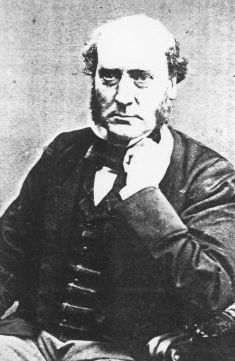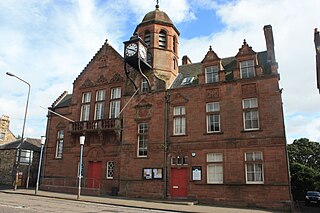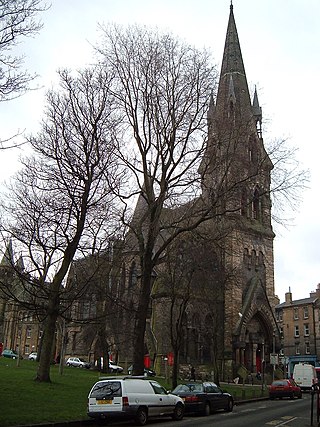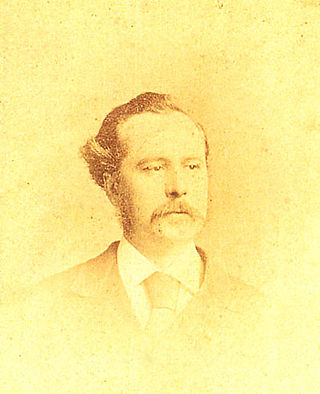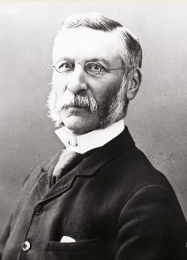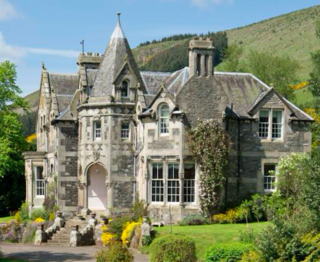Architect



Pilkington adhered closely to Ruskin's principles, and in the High Victorian tradition which they promoted he evolved a highly personal style by mixing northern medieval elements with those from the Gothic architecture of Northern Italy as published by John Ruskin and George Edmund Street. His work featured polychrome stone, chunky rustication and lavish external carving of Venetian medieval buildings combined with French rose windows, decorated tracery, high-pitched roofs and deep, rain-conscious porches. [6]
In 1854 Pilkington's practice exhibited designs for a church and workers' housing at the Royal Scottish Academy in Edinburgh. After attending the University of Edinburgh in 1858 he designed and built Inchglass, a large Gothic Revival villa at Crieff, Tayside.
By 1860 Pilkington had secured the patronage of the papermakers John and Charles Cowan in Penicuik and in 1861 secured their commission for the Scottish National Institution for the Education of Imbecile Children at Larbert, Falkirk. Approximately five years later he also obtained the patronage of Henry Ballantyne (1802-1865) to build villas for the Ballantyne family in Walkerburn, and to design and build a new village with houses for the Ballantyne mill workers. Two of the villas, The Kirna (1867) and Stoneyhill (1868) were characterized by richly sculptured Venetian Romanesque designs, with Moorish influences. [4] These designs were also found in his own house Egremont (1865), 38 Dick Place, Edinburgh and Craigmount Park (1869).
Between 1861 and 1866 Pilkington secured commissions for Trinity Church (1861-3), Irvine, Strathclyde, The Moray Free Church (1862), Edinburgh, South Church (1862-3), Penicuik, Lothian, and St John's (1862-6), Edenside, Kelso, Borders. [7] The most dramatic was the Barclay-Bruntsfield Church (1862-4), Edinburgh, with its landmark spire, unprecedented conical cluster of prismatic sections crowning the apses of the heart-shaped plan. All follow the same basic concept of a large galleried auditorium, transformed to a Greek cross at the upper level. All his churches of this period include rich naturalistic carving, including some of his smaller designs at Auchengray (c. 1865), Strathclyde, and Innerleithen (c. 1865), Borders. [8] In 1866 he designed the Marykirk church in Stirling, commissioned by Christian Maclagan, which shared many of these features, although the kirk was built on a difficult site and was pulled down in 1954; full records of its style do not remain. [9]
By the mid-1860's his earlier use of polychrome masonry was replaced by more conventional plans last at Windsor Place Church (1866), Cardiff, Glamorgan.
In 1867 he went into partnership with John Murray Bell (1839-1877) to form Pilkington & Bell, Bell providing the structural know-how, Pilkington providing the design flair.
At the Eastern Club (1868), Dundee, Pilkington combines Romanesque and Renaissance motifs. By 1874 at Dean Park House, Edinburgh, he turned to a giant-scales contemporary French style. [10]
In 1883, Pilkington moved to London after he was commissioned to work the Army and Navy Hotel (1180-2), Victoria Street. His move to London did not lead to any other major commissions. His practice transitioned to designing residential flats for both the Artisans, Labourers & General Dwellings Company and for the middle-classes. This second category of flats include Campden Hill Court, Kensington and York Mansions, Battersea.
Pilkington did not see the completion of York Mansions, his last commission, as he died before its completion in 1901.










